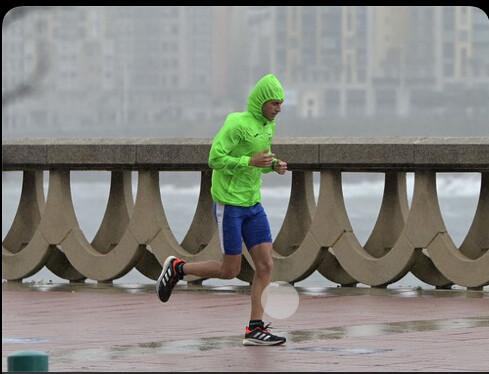Running News Daily
Running News Daily is edited by Bob Anderson. Send your news items to bob@mybestruns.com Advertising opportunities available. Train the Kenyan Way at KATA Kenya and Portugal owned and operated by Bob Anderson. Be sure to catch our movie A Long Run the movie KATA Running Camps and KATA Potato Farms - 31 now open in Kenya! https://kata.ke/
Index to Daily Posts · Sign Up For Updates · Run The World Feed
How to Use the Run/Walk Method for Faster Times and Longer Distances
Adding walk breaks to your training runs and races just might provide your ticket to faster finishes or longer distances.
Many runners have a few dirty little secrets, like not quite making it to the bathroom or chafing in unmentionable spots. But one thing many runners also won’t admit to... walking. That is, unless you embrace the run/walk method, which involves adding precisely planned walk intervals to your runs.

The run/walk method can offer runners many benefits, including helping to fight off fatigue. It can even help you clock faster finish times and maybe even win a race that you thought was out of reach. Just look to Marc Burget for evidence. A ultramarathon run/walker, Burget, 50, won the 2016 Daytona 100 (miles) in 14 hours and 14 minutes which, at the time, was a course record.
“The idea that you should move from walking to running is the wrong framework,” Burget, director of operations at Bailey’s Health and Fitness in Jacksonville, Florida tells Runner’s World. “Instead, putting walks in my race plans allows me to go the whole 100 miles without becoming tired.”
Research supports Burget’s experience. According to a 2016 study published in the Journal of Science and Medicine in Sports, of the 42 runners studied, those who used the run/walk method in a marathon reported less muscle pain and fatigue and finished with similar times, compared to those who only ran.
So, while it’s true that runners typically move faster than walkers, it’s also true that during long races or training runs, taking well-timed walk breaks can help you reach your goals. To understand the run/walk method, here are common myths and truths about the training and racing strategy, plus how to test out the system for yourself.
Myth: Only Slow Runners Use the Run/Walk Method
Truth: Slow Walks Support Faster Finishes
In recent years, more runners and experts have learned that zone 2 running (that is, lower effort runs), improves many elements of fitness and supports your ability to run both long- and short-distance races without fatiguing as quickly.
Whatever distance you race, it’s important to manage your energy levels from the start, so you can make it to the finish without bonking. While fuel plays a role in maintaining energy, how you pace a race is also crucial.
“There’s a myth that a lot of runners perpetuate about banking time,” Chris Twiggs, chief training officer at Galloway Training Programs tells Runner’s World. “The time bank doesn’t exist. The bank that does exist is the bank of energy. When you walk during your run, you are investing in the bank of energy.”
Burget agrees. The first time he ran 100 miles, he planned to run the whole way, but because of exhaustion, he ended up walking about 20 miles. Once he started to train with the run/walk method, he cut his walking down to 10 to 15 miles thanks to 30-second walk intervals. Now, with experience, most of his ultras include eight to 10 miles of walking and he either alternates three minutes of running and 30 seconds of walking, or 0.3 miles of running and 30 seconds of walking, depending on his race strategy and goals.
How to use the run/walk method to get faster:
If you have your mind on a PR, the run/walk method could help you get there. You just have to practice.
“Your walk should be brisk, but not work,” says Burget. “You want your heart rate to drop down.” You also want to give your muscles a break from the intense effort to allow for a midrun recovery.
Because you’re walking, you also need to make your run intervals faster than if you’re going for a steady-state run. For example, let’s say you want to average an 8-minute per mile pace for a marathon. Try running a 7:40 pace for nine-tenths of a mile, then walk for 30 seconds, so that you finish a mile in eight minutes. “You’re not losing 30 seconds,” Burget explains. “You’re moving forward, but part of your pace is a walk.” Likewise, if you want to maintain an 11-minute pace, you could do a 40-second walk every three minutes of running at around a 10:20 pace per mile.
If you have been running for a bit but you don’t know where to start with your interval ratios and paces, do a “magic mile” run, both experts say. This will help set your goal pace for a race. With that magic mile time in mind, set your interval ratios, keeping in mind that generally, the faster your average pace, the longer your run intervals. For example, if you’re aiming for an 8-minute mile average pace, you may run three minutes and walk 30 seconds. But if you’re aiming for a 10-minute mile average pace, you may run 90 seconds and walk 30 seconds.
If you’re a beginner, Twiggs suggests starting your workouts by running for 30 seconds and walking for 30 seconds. If that seems too easy or you can feel yourself wanting to run more keep the 30-second walk, but run slightly longer between walks, he says.
You can keep track of your ratio using time or distance. Twiggs uses time, while Burget often pays attention to the mile markers in his races, walking for the last tenth of each mile. Play around with what works best for you.
“It took me a few months to figure out the ratio that works for me,” says Burget, who has also run a 2:50 marathon by alternating six-minute runs and 15-second walks.
When you want to actually increase your average pace per mile, do another magic mile to see how much faster you can go, and then either increase the speed of your run intervals, add more time to the run intervals, or cut down on the time of your walk breaks.
Myth: Only Beginners Take Walk Breaks
Truth: The Run/Walk Method Can Work for Everyone
While there are no statistics on how many runners use walks in their training or in their races, how long they’ve been running, or how “tired” any runner is when they walk, we can confidently say that runners who strive to incorporate walks into their runs are all ages and all levels of fitness.
Both Burget and Twiggs run ultras, something less than 1 percent of Americans did in 2023, and ultrarunners typically aren’t new to the running game.
In fact, planning your run/walk strategy for races can take practice so many experienced runners and walkers may turn to it. For example, Burget has learned to time his walks to match the location of hydration stops and elevation gain in his ultras so he can maximize his running potential. But that came with lots of practice using the run/walk method.
How to use the run/walk method to advance your race results:
Always study the details of your upcoming race and consider creating a strategy to match walks with water stations and hills. “Looking at the landscape when planning your run/walk is important,” says Burget.
“Walking hills is smart because we want to do what we can to conserve our energy so that when we expend our energy we get the most bang for our buck,” says Twiggs.
Running up hills during training will help you build leg strength, but in a race it could decrease your pace (and finish time) because it takes so much effort, adds Twiggs. Without planning, you might find yourself running up a hill (wasted effort) and then walking a descent as you recover. Planning ahead can help you flip that to maximize your energy and increase your speed.
The point: Go into your race with a clear plan that has specifically planned walk breaks so you’re not just slowing it down when you feel like it, which could be a detriment to performance, Twiggs explains. Playing around with your run/walk ratios during training will also help you set this in stone come race day.
Myth: Being a Run/Walker Will Limit Your Race Opportunities
Truth: Walks Can Help You Participate in Longer, Harder Races
The reason running is defined as “high” intensity while walking is considered “low to moderate” intensity is because it takes more energy to run than to walk. Typically, your heart beats more frequently when you run than when you walk in order for your body to produce that extra effort.
Break up those runs with walks, though, and you are giving your heart, muscles, bones, and joints a break. It’s helps with the deposit into your energy bank, as Twiggs says. The benefit of those deposits? You may be able to add to your race schedule, say by running a half marathon instead of a 10K, if that has seemed out of reach. If you think you can’t run a marathon, could you run/walk one?
To prove the point that adding walks into long runs can cut down on fatigue and help you go longer (or even run more frequently), take another example from Burget: In 2023, he ran seven marathons in seven consecutive days, aiming for a sub-three-hour finish for each race. While he ran just over three hours in two of the races, his other times ranged from 2:52:15 to 2:58:57. “I used the same interval for each race,” Burget says, “a 20-second walk during each mile.”
How to use the run/walk method to run longer:
While you experiment with run/walk intervals, try to notice how you feel in comparison to runs that don’t include walks. Do you feel like you can increase your typical run distance or duration by a half-mile or 10 minutes?
To progress to longer distances, you have a variety of options: You can increase the pace of your runs or shorten the walk breaks you take, says Twiggs, while still running for the same overall amount of time. (This will increase your average pace.) Or you can maintain your pace and your ratio, but add more rounds of intervals, so you run for a longer duration and therefore, distance, which may come easier than only running because of the added recovery element. Do what feels best for you.
In addition to helping you conquer longer distances, the run/walk method might increase your race options by also allowing you to take part in multi-day events, such as runDisney weekends or Philadelphia’s Marathon Weekend, which includes an 8K, half, and marathon.
While some runners, of course, take part in these events without using the run/walk method, “we’ve seen anecdotally that for millions of runners, this allows them to run races they would not have otherwise considered,” says Twiggs, because it can allow for that quicker recovery.
Login to leave a comment




